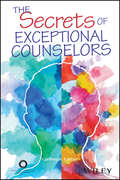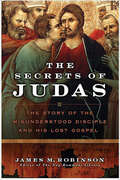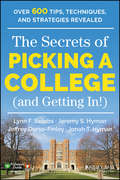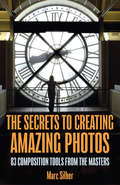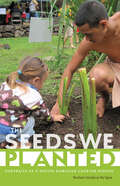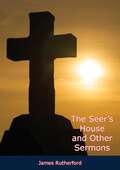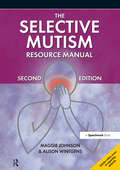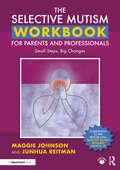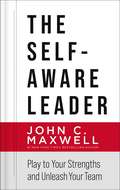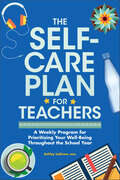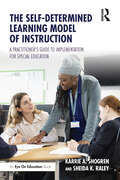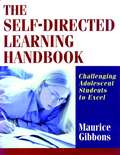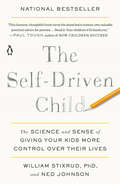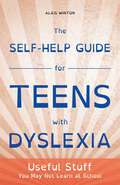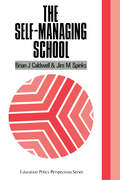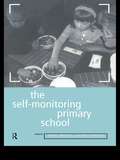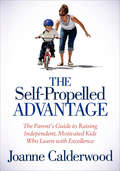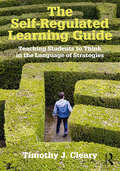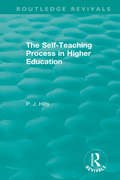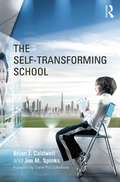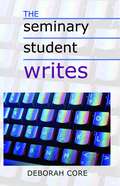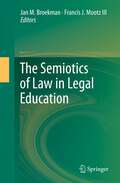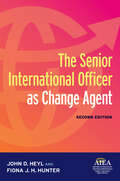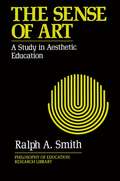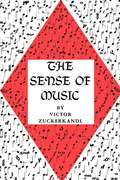- Table View
- List View
The Secrets of Exceptional Counselors
by Jeffrey A. KottlerEvery profession has trade secrets that are passed on from one generation to the next and counseling is no exception. These cherished lessons based on wide-ranging experiences and passion for the craft are shared by masters with students and colleagues and include fresh ideas, noteworthy interventions, and even little tricks learned over time that increase both professional effectiveness and personal satisfaction. These unique practices are captured in this entertaining book that collects the wisdom of some of the most accomplished practitioners in the field, those who have been most influential in developing theoretical approaches, clinical innovations, and standards of practice. These master clinicians disclose ingenious methods and practical tips to better serve clients. Discussing techniques that have been mostly kept private until now, they talk about their creative breakthroughs, spiritual transcendences, monumental successes, and their own developmental adjustments over time. They also reveal some of their most unusual cases, disappointing failures, and disturbing deceptions, and share stories about the clients who have changed them. New practitioners and veterans alike will find innovative ways to remain fresh and engaged with clients. Because of its focus on practical knowledge and useful strategies, this book can be used as a supplemental text in a variety of introductory and advanced courses, or as an inspirational guide for experienced counselors. *Requests for digital versions from ACA can be found on www.wiley.com. *To request print copies, please visit the ACA website here. *Reproduction requests for material from books published by ACA should be directed to permissions@counseling.org
The Secrets of Judas: The Story of the Misunderstood Disciple and His Lost Gospel
by James M. RobinsonProfessor Robinson’s new book, The Secrets of Judas, should be read alongside the National Geographic volumes for another perspective. — New York TimesAmerica’s leading expert on ancient religious texts from Egypt. — Lisa Ko, author of The Leavers
The Secrets of Picking a College (and Getting In!)
by Jeremy S. Hyman Lynn F. Jacobs Jonah T. Hyman Jeffrey Durso-FinleyTwo award-winning professors, a former admissions officer at a major university (now a counselor at a prestigious high school), and a gifted high school senior (now in the throes of the college admissions process himself) team up to offer you over 600 tips, techniques, and strategies to help you get in to the college of your choice. Comprehensive, yet easy-to-read, this book will teach you: How to size up the colleges you're considering--and come up with a coherent list. What are college nights, college fairs, and college rep visits--and how you can use each to your advantage. What are "holistic," "contextualized," and "legacy" admissions--and how each can work for you. How some schools count "demonstrated interest"--and how you can take advantage of this little-known fact. What are Early Decision, Early Action, and Single-Choice Early Action--and whether any is right for you. How to figure out the true costs of college, and what is the difference between "need-" and "merit-based" aid. What it means when colleges say they meet "100% of demonstrated financial aid" and what "loan-free" means. When and how to make campus visits--and what to do on each. How to prepare for each section of the ACT or SAT--and how to increase your scores. What admissions officers are looking for in your application--and how to give it to them. How to write the all-important Common App essay--and present your extra-curricular activities. How to prepare for an alumni interview--and present yourself in the best light. Whom to ask for letters-of-recommendation--and how to help them write the best possible letter. How to compare your final offers--and, in some cases, substantially improve them. When it's good to wait out the "wait list"--and when not. -and much, much more. When you understand the college admissions process, you can maximize your chance of success. Why not put yourself ahead of the pack?
The Secrets to Creating Amazing Photos: 83 Composition Tools from the Masters
by Marc Silber&“This friendly book leads us clearly and gracefully from the basics to advanced techniques in photography composition . . . highly recommended.&” —Brian Taylor, executive director, Center for Photographic Arts There&’s a common misconception that composition is mysterious and that only certain people have that natural gift for the techniques involved. The truth is that composition involves a set of skills that you can master. Just as you can use cookbook recipes to make your favorite meal—you don&’t have to be a famous French chef—you also can take amazing photos by just following a recipe! Marc Silber has spent years studying the works of masters and interviewing some of the biggest names in photography. The Secrets to Creating Amazing Photos puts at your fingertips ideas for improving your skills by giving you easy-to-follow &“recipes&” that will improve your photography right now! Composition is one of the biggest keys to creating photos that others will love. No matter what kind of camera or smartphone you&’re using, you can take your photography to the next level and beyond by learning composition tools and secrets known to the masters of the art. With this handy guide, you can flip to the look you want on the spot and follow the recipe for creating an image that inspires you. Use it when you&’re out photographing to get new ideas and inspiration. &“Buy it, read it and then apply what you have learnt from this superb new book . . . This is a complete must-have, a veritable cornucopia of wisdom gained over decades of experience.&” —Gray Levett, editor of Nikon Owner magazine
The Seeds We Planted: Portraits of a Native Hawaiian Charter School (First Peoples: New Directions in Indigenous Studies)
by Noelani Goodyear-Ka'opuaIn 1999, Noelani Goodyear-Ka&‘ōpua was among a group of young educators and parents who founded Hālau Kū Māna, a secondary school that remains one of the only Hawaiian culture-based charter schools in urban Honolulu. The Seeds We Planted tells the story of Hālau Kū Māna against the backdrop of the Hawaiian struggle for self-determination and the U.S. charter school movement, revealing a critical tension: the successes of a school celebrating indigenous culture are measured by the standards of settler colonialism.How, Goodyear-Ka&‘ōpua asks, does an indigenous people use schooling to maintain and transform a common sense of purpose and interconnection of nationhood in the face of forces of imperialism and colonialism? What roles do race, gender, and place play in these processes? Her book, with its richly descriptive portrait of indigenous education in one community, offers practical answers steeped in the remarkable—and largely suppressed—history of Hawaiian popular learning and literacy. This uniquely Hawaiian experience addresses broader concerns about what it means to enact indigenous cultural–political resurgence while working within and against settler colonial structures. Ultimately, The Seeds We Planted shows that indigenous education can foster collective renewal and continuity.
The Seer's House and Other Sermons
by James RutherfordA fantastic collection of devotionals from Scottish preacher James Rutherford.“One feels that the preacher of these sermons truly lives in the Seer's House. Somehow Scotland is the preaching-center of the English-speaking world, and this series is by no means inferior to the high standard of the Scottish pulpit. Such simplicity, insight, strength, tenderness, directness, and clarity might well be coveted by any preacher.”-Journal of Religion, Vol. 44, no. 6.
The Selective Mutism Resource Manual: 2nd Edition
by Alison Wintgens Maggie JohnsonFor anyone who needs to understand, assess or manage selective mutism, this is a comprehensive and practical manual that is grounded in behavioural psychology and anxiety management and draws on relevant research findings as well as the authors' extensive clinical experience. Now in its second edition and including new material for adolescents and adults, The Selective Mutism Resource Manual 2e provides: an up-to-date summary of literature and theory to deepen your understanding of selective mutism a wealth of ideas on assessment and management in home, school and community settings so that its relevance extends far beyond clinical practice a huge range of printable online handouts and other resources case studies and personal stories to illustrate symptoms and demonstrate the importance of tailored interventions. This book is essential reading for people who have selective mutism as well as for the clinicians, therapists, educators, caseworkers and families who support them.
The Selective Mutism Workbook for Parents and Professionals: Small Steps, Big Changes
by Maggie Johnson Junhua ReitmanThis workbook provides hands-on Activities, Strategies, planning sheets and progress trackers for use with children with selective mutism at home, at school and in the wider community. Written by selective mutism expert Maggie Johnson and parent coach Junhua Reitman, the workbook includes first-hand accounts of how children can overcome SM successfully using the Activities and Strategies described in this book. Activities are organised around the daily routines of school and family life and each Activity is broken into a progression of small steps with appropriate Strategies and an accompanying record sheet to track progress. Activities include: • Using the toilet at school • Attending social gatherings • Organising a successful playdate • Initiating conversation • Talking in the classroom • Eating with peers This workbook is essential reading for parents, professionals and anyone who is looking for a toolkit for selective mutism. It also provides a useful extension to The Selective Mutism Resource Manual, 2nd edition, focusing on the ‘how’ to complement the manual’s ‘what’ and ‘why’. Small steps really do lead to big changes but taking the first step can be the most difficult. This book helps you make that first step.
The Self-Aware Leader: Play to Your Strengths, Unleash Your Team
by John C. MaxwellWhat&’s the single greatest obstacle leaders face in their development, effectiveness, and advancement? Lack of self-awareness! Dr. John C. Maxwell's The Self-Aware Leader will help any leader become more self-aware, focused, and confident. In this short yet insightful volume, you will learn how to:gauge your effectiveness as a leader,make better choices that lead to success,discover and correct your own mistakes,improve your leadership with the team, andmake the right trades in your career.With fifty years of leading and teaching experience, Maxwell, the most influential leadership expert in the world, can help you become your best leadership self. The Self-Aware Leader is great for:men and women of all ages.new and seasoned leaders who want to avoid micro-managing, handle criticism with grace, and give others the credit they deserve.new and seasoned managers looking to identify their strengths, become a better learner, and improve listening skills.When leaders don&’t see themselves clearly, understand their strengths and weaknesses, or recognize their negative interactions with their team, they limit their influence and undermine their own effectiveness. What&’s the solution? Become a self-aware leader.
The Self-Care Plan for Teachers
by Ashley LaGrowPrioritize your mental health and create a more successful classroomTeaching is as demanding as it is rewarding—and focusing on self-care will help you feel your best so you can be there for your students. Find practical ways to prioritize your well-being with this self-care guide, created especially for teachers. It's organized to help you through the entire school year, with weekly prompts, practices, and tips to help you alleviate stress and feel energized to take on the next lesson!A plan for the year—Feel great with 36 weeks of inspiration and self-care activities, including taking yourself on a field trip, creating a gratitude jar, and indulging in your favorite food.Time to reflect—Solidify your self-care routine as you think about the benefits of each week's activities—from setting intentions to keeping a calendar, and making time to have fun.Brighten your outlook—Cultivate a sense of calm with uplifting affirmations that help you adopt a more positive mindset and keep you centered.Discover how you can manage school-year stresses with advice from this supportive self-care book.
The Self-Determined Learning Model of Instruction: A Practitioner’s Guide to Implementation for Special Education
by Karrie A. Shogren Sheida K. RaleyThis practical guide introduces the Self-Determined Learning Model of Instruction (SDLMI), an evidence-based practice designed to promote student self-determination and support educators in enabling students to set goals, create action plans to achieve those goals, and self-evaluate their progress. Chapters explore integration with Multi-Tiered Systems of Supports and culturally sustaining implementation of the SDLMI. Hands-on tools for using the SDLMI to support students engaging in academic learning, transition planning, and community-based activities are provided. This guide also features stories from self-advocate SDLMI researchers and teachers highlighting how the SDLMI can be put in practice. Clear and comprehensive, this book is an essential resource for every educator.
The Self-Directed Learning Handbook: Challenging Adolescent Students to Excel
by Maurice GibbonsThe Self-Directed Learning Handbook offers teachers and principals an innovative program for customizing schooling to the learning needs of individual students-- and for motivating them to take increasing responsibility for deciding what and how they should learn. Whether the students are struggling or proficient, the program is designed to nurture their natural passion for learning and mastery, challenging them to go beyond the easy and familiar so they can truly excel. The program can be introduced in stages in any middle or high school classroom and enables students of diverse abilities to design and pursue independent course work, special projects, or even artistic presentations, community field work or apprenticeships.
The Self-Driven Child: The Science and Sense of Giving Your Kids More Control Over Their Lives
by William Stixrud Ned Johnson&“Instead of trusting kids with choices . . . many parents insist on micromanaging everything from homework to friendships. For these parents, Stixrud and Johnson have a simple message: Stop.&” —NPR&“This humane, thoughtful book turns the latest brain science into valuable practical advice for parents.&” —Paul Tough, New York Times bestselling author of How Children SucceedA few years ago, Bill Stixrud and Ned Johnson started noticing the same problem from different angles: Even high-performing kids were coming to them acutely stressed and lacking motivation. Many complained they had no control over their lives. Some stumbled in high school or hit college and unraveled. Bill is a clinical neuropsychologist who helps kids gripped by anxiety or struggling to learn. Ned is a motivational coach who runs an elite tutoring service. Together they discovered that the best antidote to stress is to give kids more of a sense of control over their lives. But this doesn't mean giving up your authority as a parent. In this groundbreaking book they reveal how you can actively help your child to sculpt a brain that is resilient, and ready to take on new challenges.The Self-Driven Child offers a combination of cutting-edge brain science, the latest discoveries in behavioral therapy, and case studies drawn from the thousands of kids and teens Bill and Ned have helped over the years to teach you how to set your child on the real road to success. As parents, we can only drive our kids so far. At some point, they will have to take the wheel and map out their own path. But there is a lot you can do before then to help them tackle the road ahead with resilience and imagination.
The Self-Help Guide for Teens with Dyslexia: Useful Stuff You May Not Learn at School
by Alais WintonAs Alais Winton knows, having dyslexia doesn't mean you're not bright; like her, you might just need a different way of looking at things. In this book, she lets you in on the learning techniques which work for her, and which you may not be taught at school. Offering solutions to common problems students with dyslexia face, Alais describes tried-and-tested techniques for succeeding with reading, spelling, memorising information and time management, and even a simple method to ensure you never misplace your learning tools (such as pencils and books) again. The strategies are ideal for use in the run-up to exams, helping you to become more organised, less stressed and better prepared. This is a must-read pocket guide for students with dyslexia aged 11 to 18, and will also be a helpful source of ideas for teachers, SENCOs and parents of teens with dyslexia.
The Self-Managing School
by Brian J. Caldwell Jim M. SpinksFirst published in 1988. Routledge is an imprint of Taylor & Francis, an informa company.
The Self-Monitoring Primary School (Education Management Ser.)
by Cyril Poster Pearl WhiteThis book is a practical guide to help primary school staff initiate, or further develop monitoring procedures for both the school curriculum and management. It shows how all members of staff can be involved in monitoring so that it becomes an integral feature of school development and improvement. Specific areas focused on include: * developing a quality control framework * the importance of a whole-school approach to policy making * developing a school-wide system to monitor plans * observing and promoting differentiation in the classroom * the role LEAs must play in monitoring school effectiveness
The Self-Propelled Advantage: The Parent's Guide to Raising Independent, Motivated Kids Who Learn with Excellence
by Joanne CalderwoodA home education expert and mother of eight shares her experiences and insights into harnessing a child&’s natural desire to learn. Joanne Calderwood has been a popular magazine columnist for several years and has become a popular speaker at home-education conferences across the country. Her self-propelled philosophy of education has transformed lives across the nation and around the world. In The Self-Propelled Advantage, Calderwood shares her wisdom, experience, and philosophy of education and parenting, as borne out in the lives of her own exceptional children. Informative and inspiring, The Self-Propelled Advantage is for any parent who places a high value on their children&’s education. Detailing her methods for raising inquisitive, diligent, self-motivated children, Calderwood also shares valuable information on preparing for college entrance exams like the SAT and ACT. Having taught one SAT perfect scorer, one near-perfect scorer, and four students who have gone to college on full academic scholarships, Calderwood has proven how successful her methods can be.
The Self-Regulated Learning Guide: Teaching Students to Think in the Language of Strategies
by Timothy J. ClearyThe Self-Regulated Learning Guide introduces K-12 teachers to the basics of self-regulation. Highly practical and supported by cutting-edge research, this book offers a variety of techniques for seamlessly infusing self-regulated learning principles into the classroom and for nurturing students’ motivation to strategize, reflect, and succeed. Featuring clear explanations of the psychology of self-regulation, these nine chapters provide teachers with core concepts, realistic case scenarios, reflection activities, and more to apply SRL concepts to classroom activities with confidence.
The Self-Teaching Process in Higher Education (Routledge Revivals)
by P.J. HillsOriginally published in 1976 The Self-Teaching Process in Higher Education looks at the major changes that took place in the structure of university education. The book looks at how more emphasis was placed on students to take responsibility for their own progress by becoming self-directed individuals. Traditional methods of university education and some alternative approaches are considered in light of course needs of both students and teachers. Self-teaching is then examined in the overall context of the learning process. The book looks at three case studies of the development and use of self-teaching systems, one for chemical bonding, one for electrical circuits and a third for audio-visual communication.
The Self-Transforming School
by Brian Caldwell Jim SpinksThe Self-Transforming School combines an insightful meta-analysis of factors contributing to the success of schools, and an examination of powerful mega-trends that are shaping developments in education, to offer the first mega-analysis in education policy and practice. The book spans fifty years, beginning with Caldwell and Spinks’ ground-breaking work The Self-Managing School which advocated innovative approaches that are now accepted as preferred practice, before offering a prognosis and plan for the future. The book argues that all schools in all settings can secure success for all students in an era where society and the economy are changing constantly and dramatically. Although schools find some support in local and global networks, externally designed re-structuring, re-staffing, or command-and-control direction isn’t sufficient to achieve transformation. Instead of replicating particular approaches to achieve modest improvement, leadership of the highest quality needs to be deeply embedded in schools and their systems. Caldwell and Spinks propose three important points that need to be taken into consideration:-schools are often at different stages of self-transformation -self-transformation requires a high level of professionalism, and must include teacher education and on-going professional development -funding is critically important, and efforts to build a capacity for self-transformation are constrained by what is available. The book gives particular attention to developments in Australia, Brazil, Canada, England, Finland, Hong Kong, India, New Zealand, Shanghai, Singapore and the United States. It will be of key interest to school leaders, policy makers, and academics and postgraduate students engaged in research on equity, student performance in highly disadvantaged settings and education policy.
The Seminary Student Writes
by Deborah CoreDeborah Core offers practical guidance for beginning seminary students who feel overwhelmed and under-prepared to write the number and quality of papers their courses require. The book begins with reflections on writing as a sacred action, then addresses such practical matters as choosing and researching a topic; outlining, drafting, and polishing a paper; and using the proper format for footnotes and bibliography. Also included are sample papers in MLA and Chicago styles and an overview of grammar and usage.
The Semiotics of Law in Legal Education
by Jan M. Broekman Francis J. Mootz IIIThis book offers educational experiences, including reflections and the resulting essays, from the Roberta Kevelson Seminar on Law and Semiotics held during 2008 - 2011 at Penn State University's Dickinson School of Law. The texts address educational aspects of law that require attention and that also are issues in traditional jurisprudence and legal theory. The book introduces education in legal semiotics as it evolves in a legal curriculum. Specific semiotic concepts, such as "sign", "symbol" or "legal language," demonstrate how a lawyer's professionally important tasks of name-giving and meaning-giving are seldom completely understood by lawyers or laypeople. These concepts require analyses of considerable depth to understand the expressiveness of these legal names and meanings, and to understand how lawyers can "say the law," or urge such a saying correctly and effectively in the context of a natural language that is understandable to all of us. The book brings together the structure of the Seminar, its foundational philosophical problems, the specifics of legal history, and the semiotics of the legal system with specific themes such as gender, family law, and business law.
The Senior International Officer as Change Agent
by John D. Heyl Fiona J. HunterPublished by Distributed by StylusThis new edition reflects the dramatic changes that have taken place across the world in higher education in the decade since it first was published, and addresses how they specifically impact international education and inform the role of senior international officer (SIO) today.Declining public investment in higher education and a negative political climate have increasingly led to the commercialization of international education activities and the expectation they should pay for themselves by levying fees or seeking outside funding. In addition, today’s international education leadership faces several contradictory realities. While inexorable trends in globalization continue to stimulate higher levels of participation in international study and exchange, its impacts – such as increased migration, global terrorism and the populist resistance they have provoked – are shifting institutional priorities from those of greater openness and global understanding to those of profitability and security.Facing these issues and the global competition for student talent at a time of declining enrollments; the impacts of technology; the increasing diversity on campus; pressures to partner across borders; changing emphases in institutional mission; and the expectations of both parents and students in gaining a global perspective during university studies, it’s clear that the key issue facing SIOs is managing change as colleges and universities seek to strengthen, professionalize, and centralize – or in some cases decentralize – their international offices.
The Sense of Art: A Study in Aesthetic Education (Philosophy of Education Research Library)
by Ralph A. SmithRalph A. Smith provides a theory of aesthetic education that addresses the need to revitalize the capacity for genuine judgment in society, reaffirm the ideal of excellence in culture, and reorder our thoughts about teaching the arts in schools. The book presents an image of the curriculum as itinerary, preparing the young to traverse the world of art with adroitness and sensitivity.
The Sense of Music
by Victor ZuckerkandlThis book is addressed to the listener whose enjoyment of music is filled with questions and whose curiosity makes him eager to grasp the sense of music, despite a lack of theoretical training. Unlike the usual listener's guide, which begins with a discussion of the elementary materials of music, this book starts with the elementary experiences of listening.
